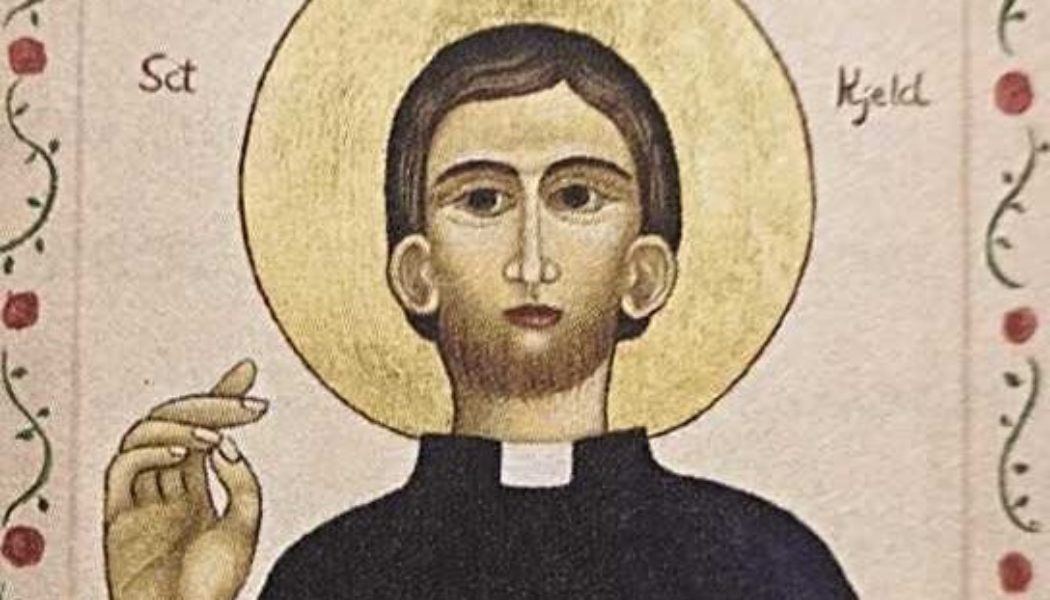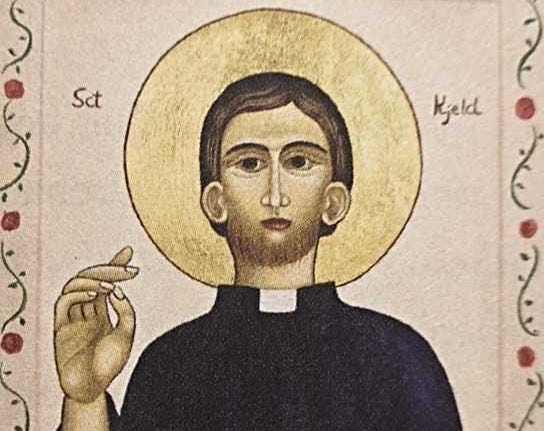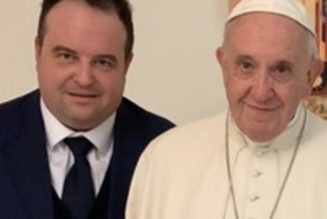Pillar subscribers can listen to Ed read this Pillar Post here: The Pillar TL;DR
Happy Friday friends,
And a happy feast of St. Kjeld of Denmark, to all who celebrate. Though I cannot imagine it’s very many of you. I’d never heard of Kjeld myself, indeed, until yesterday, if you’d put a gun to my head I don’t think I could have named a single Danish saint.
That’s not to say there aren’t plenty of them — I am sure there are — but perhaps they just keep a low profile, as I’m led to believe is the unbreachable social custom in Denmark and more broadly across the Scandinavian countries.
Being undemonstrative, not making a fuss, and not getting above your proper place is, so I am told, something of a code of life there, referred to as the “Law of Jante,” a phrase coined by the novelist Aksel Sandemose.
As I understand it, the Law of Jante is meant to express the absolute Nordic preference for egalitarianism and social conformity versus individualism. As codified by Sandemose, “you’re not to think you are anything special,” and there is, so I am told, a strong Danish culture of knocking people down a peg or two if they’re seen to be getting a bit above themselves.
Depending on whom you talk with, the Law of Jante is either responsible for Scandiland’s perennially high scores in the world rankings of human happiness and social contentment, or for its equally consistently above-average suicide rates. Maybe it’s both?
As such, I would imagine especially pious behavior or saintly conduct might be seen as a bit suspect — as it apparently was in the case of Kjeld, a 12th-century cleric who was bounced out of his role as dean of the cathedral chapter in Viborg for being too generous to the poor with the chapter’s money. After offering himself for mission (and likely martyrdom) among the Wends, the pope instead told him he’d prefer he returned to Viborg, which he did — to the considerable annoyance of his confreres there, who had to bow to papal preference.
I cannot say for sure, but it strikes me as at least possible that Kjeld’s cult hasn’t spread very far because of the quiet social censure of his being… well… unusual. That might also be the reason I seriously struggled to find an image or icon of him, too, no matter how hard I Googled.
This image — with the 12th century priest depicted in very modern dress — was the best I could find, and if it isn’t deliberately meant to dull your enthusiasm, maybe that’s just how deeply ingrained the Law of Jante is in Denmark.
Of course, Americans tend to put a high premium on individual potential and achievement, and on celebrating the exceptional. And it’s not for me to say one culture is better than the other, though I think it’s as intuitive a choice as comparing a Maersk container ship to the USS Theodore Roosevelt.
But that said, there is a potential positive spin to put on the Law of Jante, which in its full recitation can be a bit of a joyless litany. The admonition not to ever think “you” are bigger or better than “we” isn’t a million miles from St. Paul’s radical insistence on the Christian always considering the other superior to himself.
In the case of St. Kjeld, it would have taken a particular kind of humility, and a willingness to love the “we” over the “me” to see his missionary ambitions denied in favor of returning home to a community that had rejected him. It’s an example for all of us, but he is, in that sense, a very Danish saint. Even if they refuse to make a fuss about it.
Here’s the news.
The News
The Knights of Columbus have announced that they will cover up mosaics by Fr. Marko Rupnik in chapels at their HQ in New Haven and the National St. John Paul II Shrine in Washington, DC.
The knights’ decision followed a “thorough process” reviewing what to do with the artwork, given that Rupnik is accused of using his artistic process as part of his sexual abuse of dozens of religious sisters over the years.
It’s the latest such move following a letter from Cardinal O’Malley of the Pontifical Commission for the Protection of Minors last month calling for “pastoral prudence” when dealing with displays of artwork by an alleged abuser.
At this point, the only people who don’t seem to have got the memo are members of the Vatican’s own Dicastery for Communication.
—
Ever since the presidential debate last month, the age of world leaders and the mental toll high office can take on them have been much in the news.
Of course, in Pope Francis, the Church has a leader older than either presidential candidate and with arguably a much more important job to shoulder. And he’s not alone in being at the upper end of the actuary tables — lots of senior Churchmen in key roles are serving well past the nominal clerical retirement age of 75.
It’s an inevitable part of Church life that, when a pope passes a certain age, speculation starts to mount about how long he has left in office — the common consensus is that an 87-year-old pope probably doesn’t have many years left, and so we tend to get a lot of overheated coverage of every real and alleged papal health scare.
Of course, we at The Pillar hate common consensus — and we really hate uninformed speculation. So our stat guru Brendan Hodge went to work with Mary Pat Campbell, a Pillar reader (in a good way) and an actuary specializing in mortality data, to run some actual numbers.
Looking across a range of aging prelates in top jobs, the results are fascinating.
Pope Francis might be 87, but the odds are he’s likely to still be pope into his 90s — assuming, of course, he doesn’t revisit the example of his predecessor Benedict on retirement in the meantime.
Read the whole story, because you won’t get this kind of analysis anywhere else.
—
Looking ahead past polling day, the U.S. bishops have committed to redrafting their election guidance document “Forming Consciences for Faithful Citizenship” once the current election cycle is over.
As JD pointed out in an analysis yesterday, that was always going to be a complicated and potentially contentious process. But it is likely to be even more so now that the Republican Party has formally removed the pro-life planks from its platform and endorsed legislative protection for access to IVF, even as the bishops have reaffirmed their prioritizing of abortion as the “pre-eminent” moral issue to weigh.
Some bishops, JD argues, will probably want to carry on with business as usual. But they might find that hard to do.
The ordinary business of politics has already meant much of the professional pro-life political class — including some big-name Catholics in big money organizations who make big dollar contributions to political campaigns, and even some Catholic media outlets — are already lining up to endorse the new Trump line on abortion as a “winning message to 10 million voters,” while walking away from a total commitment to life and to the unborn victims of in vitro fertilization.
As JD noted, it is not clear whether the bishops will be as willing to be quite so politically pliable in their guidance to Catholics. And that could tee up some of the most creative, fractious, and theologically driven discussions among bishops in decades.
It’s a fascinating analysis. Read the whole thing.
—
Bishop Christopher Saunders appeared in an Australian court July 8 for a bail hearing as he awaits trial on 28 criminal charges, including alleged sexual abuse.
Saunders’ case is also currently before the Dicastery for the Doctrine of the Faith in Rome, where it was supposedly at an advanced stage at the time police reopened investigations into the bishop after being passed a copy of the Church’s own Vos estis report.
While no canonical decision is likely to be announced ahead of the criminal trial, it’s still unclear what he has been canonically charged with — and the Australian bishops’ conference has faced pointed questions about the case.
Last year, the conference claimed that although Saunders faced canonical trial in Rome for sexual offenses against young men, there was no evidence he had abused minors. Yet he is now facing several criminal charges of abusing boys under the age of 18 — the canonical standard of a minor.
—
The working document for October’s session of the synod on synodality was presented Tuesday at a Vatican press conference.
The 50-page text, known as the Instrumentum laboris (Latin for “working instrument”), will guide participants in the Oct. 4-27 session of the event officially styled as the XVI Ordinary General Assembly of the Synod of Bishops.
While some might delight in the unique style and prose of synodal working documents, and consider the new text an absolute treat, others might struggle to maintain their interest for the full 20,000 words.
And, for those people, Luke Coppen has put together a busy reader’s guide to what you need to know.
Upstream, a new podcast from Patrick Lencioni, provides ideas and encouragement so courageous priests can more effectively run their parishes and spread the Gospel. Pat is not only a passionate Catholic but is the pioneer of the organizational health movement and one of the world’s foremost experts on leadership and teamwork.
Look to the East
While this can seem on the surface to be just the latest in a years-long back and forth in the second largest Eastern Catholic Church’s ongoing liturgy war, there’s actually something new and very interesting here to consider, as Luke Coppen reports.
Writing in response to the appeal, Bishop Bosco Puthur said that the priests had treated the June letter as a penal precept, a particular kind of canonical instrument, which the bishop said it wasn’t — therefore their appeal is null.
But the original letter against which the priests sought to appeal seems to establish an automatic penalty of suspension from ministry, and even threatens excommunication, for any clergy who continued to celebrate the Eucharist outside of the Syro-Malabar’s approved “unified mode.”
Any who do so “will be barred from performing priestly ministry in the Catholic Church… without further warning,” the letter said.
Canonical speaking, the letter walks and quacks a lot like a penal precept, whatever the bishop might claim it actually is — and it’s not clear what else he is calling it.
That matters for a couple of reasons.
First, appeals against such acts of governance immediately suspend their enforcement.
And second, in Eastern canon law, the use of penal precepts is heavily restricted, as compared to the Latin Church.
Simply put, you can’t create automatic latae sententiae penalties in Eastern law, nor can you impose indefinite suspension from ministry, or excommunication, outside of a full canonical trial. Yet the bishop’s letter seems to do all of this — or at least attempt to do it.
You might think that this is all just straining at canonical gnats, but I would argue it is a BIG deal.
It’s a big deal because good governance and the rule of law matter in the Church, and the priests in question here have been living in pretty open defiance of the Syro Malabar Church’s legitimate authority for years. Addressing that situation is an ecclesiological imperative — but that makes doing it correctly even more important.
If the response by the Church in the East is shown to be legally incoherent (not to say invalid), and can be spun as an unjust overreach by the ecclesiastical authority, it could lend an implied justification to what is otherwise simple defiance against legitimate authority.
Of course, the bishop may be trying to thread a needle here. Maybe he’s being honest in saying his letter doesn’t actually mean to threaten and apply the penalties it says it does, but he doesn’t want to say outright the whole thing was really just a bluff that’s been called, either. That wouldn’t be unknown in the current cycle of back-and-forth.
But I spoke to a friend this week, a decorated Eastern canonist with some years’ experience of how the gears grind in Rome, and his read of the situation was that the Syro-Malabar bishops were probably just saying what Rome was telling them to say — and Rome was giving counsel without any real understanding of — or interest in — how Eastern canon law differs from the Latin code.
If that’s the case, it’s even worse than local episcopal overreach. If the Holy See’s attitude to the sui iuris nature of the Eastern Churches is basically L’eglise, c’est nous, it bodes very, very badly for the exercise of authority elsewhere.
It’s long been my suspicion that the liturgy wars in India could prove a preview for something similar in the West, if and/or when some kind of total liturgical ban were imposed on the traditional Latin Mass, with similar numbers of priests with their communities saying, in effect, “try to make us” and provoking a very severe response.
I’m increasingly sold that such a severe response would come from Rome. Arguably, the canonical issues with the Syro-Malabar letter suggest it’s coming already.
When open defiance of legitimate authority is answered with the illegitimate exercise of that same authority, you have a recipe for what the Syro-Malabar bishops are trying to avoid: schism.
Sod’s Law
I’m not sure if they have much of an appreciation of Sod’s Law in America. People speak of “Murphy’s Law,” whoever Murphy is meant to be, as an expression of the kind of irony of which Alanis Morissette would sing, but it’s not quite the same thing.
Sod’s Law holds that the complete inverse of a just or reasonable outcome should be expected in direct proportion to the relative importance of a situation. In Britain, it is thought of as a kind of foundational philosophy, a part of the cultural constitution on a par with the monarchy or the serving of beer in correctly sized pints (which you cannot buy in America, by the way).
Sod’s Law has been very much in the national consciousness over there at the moment, as the England national football team have progressed to the final of the European championship tournament. It is a result which none foresaw at the tournament’s opening, and which even the most unhinged partisans concede is totally unwarranted by the team’s performance thus far.
Far better England teams, in terms of quality of players and performances, have failed to achieve this kind of progress. Yet a misfiring pack of amoral brats, led by a superannuated captain who decamped to play in Germany, and a coach graced with the dynamic charisma of a paving slab, have managed to progress round after round.
Except for 45 minutes of what should be bare-minimum football by this team in the semifinal, England’s victories have come from nowhere, conjured up to dumbfound and delight fans after setups of such frustrating, buttock-numbing tedium that they land like the punchline to a Norm McDonald joke.
That the team succeeds, not heroically against the odds, but seemingly in spite of themselves, defies all reason and justice. It is Sod’s Law. And it has occasioned an amusing illustration of the English national character.
It’s hard to explain the cultural significance of the England team to that country.
There is no real American equivalent — this country is too big, geographically and culturally, to invest itself with total emotion in international sporting endeavors. American “world championships” are won at club level, in sports played (by and large) nowhere else apart from two or three Canadian cities.
But for England, the national football team serves as a kind of avatar for the popular psyche, a roiling mixture of pride in past glory and self-loathing at contemporary mediocrity.
Previous teams have gone down in devastating moments of loss of self-confidence (current manager Gareth Southgate’s missed penalty in ‘96) or dramatic acts of self-sabotage (David Beckham’s red card in 1998). Each failure fueling a national sense of aggrieved injustice and a kind of morbid reveling in inevitable disappointment.
Even the most popular English football-themed songs are melancholic expressions of frustrated hope after decades of pain.
Now, fans have to contend with the joyful hope of an improbable victory by a team at whose manager they were throwing beer cups in disgust after (another) anemic draw earlier in the tournament.
Sunday’s final against Spain promises, on paper, certain defeat for England. And should that happen, the team will likely be afforded a muted and confused reception back home, before demands for the coach’s resignation resume. They will be branded mediocrities who managed to fall up, round after round, before being found out in the final, but still feted for getting that far.
That would make sense. It would be reasonable.
Of course, they could fluke to one final victory — a continental championship that would vindicate players and coaches, cementing an unloved and underperforming team into national sporting legends. All that came before would be forgiven and forgotten in a heartbeat, with national celebrations and knighthoods all around.
In our house, we will be glued to the final like everyone else back home. And we’ll watch with gritted teeth through the cracks between our fingers. We’ve taught our daughter to chant “Football’s coming home” and, in due course, we’ll teach her to wallow in her frustration when it doesn’t.
Except if it does. That would be Sod’s Law. And in Sod’s Law we still believe.
See you next week,
Ed. Condon
Editor
The Pillar
Upstream, a new podcast from Patrick Lencioni, provides ideas and encouragement so courageous priests can more effectively run their parishes and spread the Gospel. Pat is not only a passionate Catholic but is the pioneer of the organizational health movement and one of the world’s foremost experts on leadership and teamwork.
Comments 15
Services Marketplace – Listings, Bookings & Reviews












